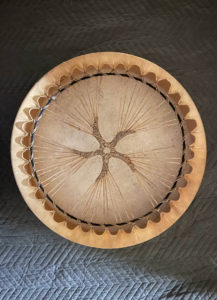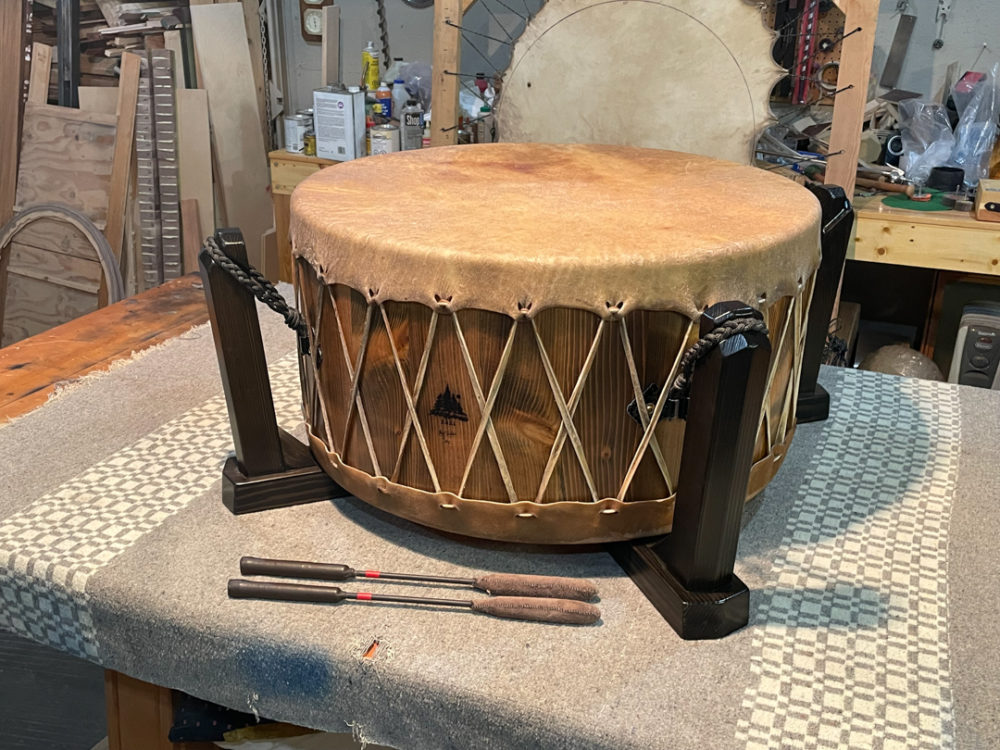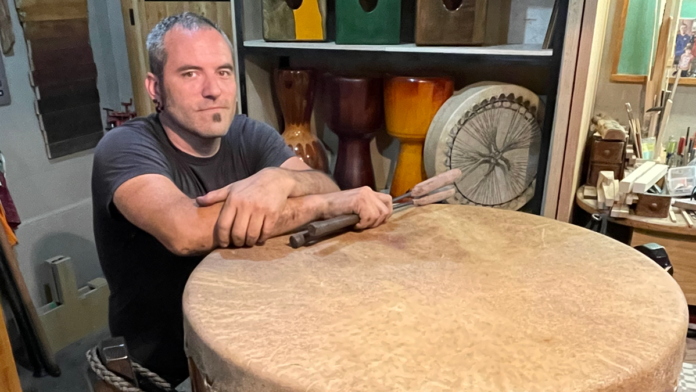Weber has been building high-quality drums and fine furniture for the last 18 years. After many years as a tradesman, timber framer, and woodworker, his passion for woodworking naturally combined with another of his passions — music. The result is a creative process and commitment to produce some of the world’s best drums.
Weber builds a variety of drums from around the world: djembes from Africa, cajóns from South America, traditional hand drums, and the large powwow drums used to lead traditional ceremonies in Canada and North America.

One important element for Weber is that the materials are all harvested in a respectful manner. He hand-mills the local red cedar used for this drum frame using his own chainsaw and portable mill. The logs are cut to specific thicknesses, dried, and then cut to rough dimensions for the drum. The thick moose hide was donated by a member of the local Stó:lo community. If the materials are locally sourced in small batches, Weber feels the drum’s construction, tuning, and sound will resonate with people on a much larger scale than production line drums.
“It’s nice to build something so big the world can hear it. I think if there’s ever a time to be heard, it’s now,” says Weber.
Weber explains the time it takes to build a drum as he shows me around his shop. “After harvesting the wood, it takes years to dry. I cut and hand-mill the wood myself, and so I have a portion of my shop dedicated to drying wood.”
The room of tools, machinery, and projects is neatly organized in comparison to the stacks of wood. There’s so much wood that he has a second room just for it and has had to turn his storage container into a drying station for green wood. I look at the stacks of wood and see so many different varieties, shapes, and sizes that it’s difficult for me to comprehend what’s what.
Weber sees my overwhelmed look and takes some time to explain the many differences between elements of the wood. The heartwood, sapwood, grain, and the varying grades of hardness or softness all contribute to the quality of the drum. He understands how the different woods impact the sound, and he is meticulous about the importance of choosing the right wood for each drum.
Weber also prepares the natural hides used as the “skin” of the drum. The skin is the part of the drum that gets battered (in other words, hit) with the percussion or drum mallets that are used like drumsticks to pound the stretched hide. To make it pliable, thick moose hide is soaked for a week or more. The hide is then scraped, stretched, and dried. The preparation of the hide takes almost as long as the wood.
Once the wood and hide are ready, Weber starts to create his drum. The process can take weeks as he hand-crafts every piece of the drum so it sounds the way he intends. When asked about the sound he’s looking for in the drum, he explains the amount of time and experience he has playing drums and music and how that contributes to the process. A lifetime of developing his “ear,” the ability to identify and recreate a specific musical note, allows him to tune the drum to his exact specifications.
With Weber’s years of experience creating and playing drums, he’s a firm believer in the healing power of music and drums in particular.

“The benefits of sound therapy are now being realized, and I’ve become an aspiring sound healer because I know the benefits of playing, listening to, and creating music. The power of the drum is something to behold, and I will continue building drums and getting them into the hands of performers and influencers looking to help and heal people.”
It’s obvious from looking around Weber’s shop that he is a master craftsman. It’s filled with various projects on-the-go, and he has shelves of finished drums and furniture ready to complete orders. Every piece has been expertly finished and not an imperfection can be found.
“I do this because I love to create. The more I put into a piece, the more positive impact I feel it will have when it’s in the hands of the people who commission my work.”
Weber is eyeing his future projects as requests for appearances and new orders stack up. He’s balancing his intense production schedule with family and work commitments and welcomes the challenges he sees on his horizon. “My next project is already in the planning stages. It’s a larger 48-inch drum.”
Images: Steve Hartwig/The Cascade
Steve is a third-year BFA creative writing/visual arts student who’s been a contributing writer, staff writer and now an editor at The Cascade. He's always found stories and adventures but now has the joy of capturing and reporting them.


